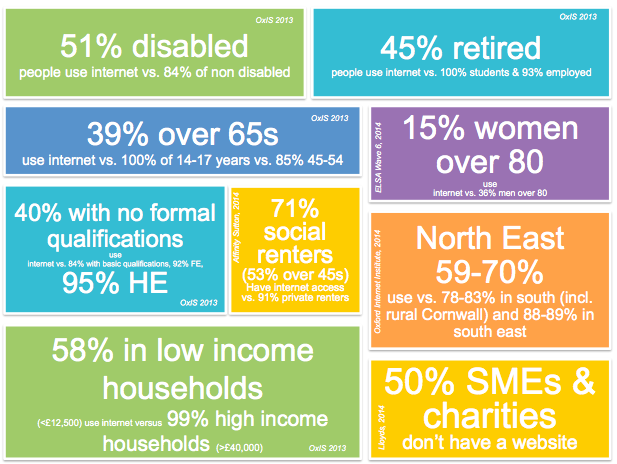Our last research blog looked at the ‘what’ of digital inclusion, considering a range of measures that can enable us to meaningfully track progress and assess the impact of our activities. Measuring digital inclusion in the general population is, of course, critical to ensuring that we’re on track to meet our targets. However, to make progress on the ‘final fifth’ who remain offline and who lack the skills and confidence to make the most of being online, there is a growing need for a highly targeted response going forward.
We now need to turn our attention to the questions: who is in need of digital inclusion support, where, and why (i.e. what are the key barriers)? And, critically, how do we effectively intervene to make the most difference?
Targeting our efforts to tackle ‘digital divides’
Despite rapid adoption of digital technologies over the last 10 years, uptake has not been equal across the population. So-called ‘digital divides’ have narrowed over time, but Internet use in Britain is still strongly stratified by age, (dis)ability, income, education and locality. We also see great variation in people’s capabilities and activities, and the utility people get from the internet. For example, people in lower social grades, and older people are more likely to lack basic online skills (BBC 2014), and are also more likely to be ‘narrow’ and ‘newer’ users (Ofcom 2014). And, people with higher household incomes, and with more education, and those in employment or education, are more likely to realise the benefits from using the internet - whether it’s saving money, finding health information, or finding a job.
We need to make digital engagement appealing to everyone, if we want to realise our ambitions of making the UK the most digitally inclusive nation. To do this, it’s crucial that we focus our effort on reducing digital divides rather than simply focussing on ‘quick wins’ - or, we risk perpetuating inequalities. We need to focus on those with the most to gain by getting online - often those segments of society who are vulnerable and disadvantaged, and with the most to lose by being offline. To do this, we’re working to develop a segmented understanding of who remains digitally excluded, where and why. A segmented, targeted evidence base will enable us to focus efforts and investment where it will make the most difference.
As part of this segmentation exercise, GDS is coordinating a survey, funded by a number of government departments, seeking to size, identify the characteristics of, and understand the support needs of digitally excluded service users. We’re also scoping the literature, examining existing datasets and carrying out in-depth interviews with users and practitioners to identify and understand the needs of vulnerable groups. In parallel, our Research Working Group is drawing together existing knowledge about the characteristics of different segments in terms of barriers and facilitators of digital inclusion. This will help inform the development of appropriate interventions and evaluation criteria.
Here, it’s critical that we work in an evidence-based way, and do not make assumptions about who is most in need of our support. For example, we’re inclined to see young people as ‘digital natives’ and, yes, some evidence does show that some groups of young people are more likely to be online than older people (e.g. OxIS 2013 finds that 100% of students are online, compared with 45% of retired people). However, among young people as a group, there is great variation when it comes to digital literacy. According to Prince’s Trust research with 15 to 25 year olds, more than one in 10 young people (12%) do not think their computer skills are good enough to use in the job they want - while almost one in five unemployed young people (18%) claim to feel this way. One in 10 unemployed young people cannot send their CV online, while more than one in six (17%) admit they do not apply for jobs which require basic computer skills. And, a quarter of unemployed young people "dread" filling in online job applications and one in 10 admit they avoid using computers, and are ‘embarrassed by their lack of computer skills.
How to intervene? Putting the user at the centre
As the example above suggests, we need a really segmented understanding of who is digitally excluded, where, and why, to target our responses effectively. But, in practice, answering the question of ‘how’ to respond is a bit more complex.
We’re all now relatively well-versed in what the key barriers to digital inclusion are: lack of access to devices or internet connection, lack of skills and, increasingly, low motivation or interest. But each individual experiences their own particular combination of barriers and these vary by age, (dis)ability, income and education, and geography. Because of this, a holistic approach, that puts user needs and motivations at its centre, will be vital. A generic, one-size-fits all approach is unlikely to succeed; there will be no single model for success.
So, as well as developing a segmented understanding of the problem, a fundamental area of focus is to develop an equally segmented understanding of ‘what works’ to motivate, engage and empower harder to reach groups with digital technologies. This will help inform the development of appropriate interventions and evaluation criteria, that respond to diverse contexts and diverse user needs.
Wherever possible, we’ll be developing this insight with users themselves, and learning from frontline practitioners who have a close understanding of user needs, to complement and expand on what the statistics are able to tell us. The statistics can tell us the big picture of ‘what’, ‘who’, and ‘where’, and begin to answer some of the ‘why’ - but answering the ‘how’ means going beyond the numbers and tapping into the real experiences and needs of real people. Watch this space for more - or, get in touch and share your own experiences with us!
